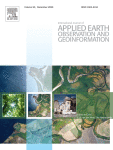Ver ítem
- xmlui.general.dspace_homeCentros Regionales y EEAsCentro Regional Buenos Aires SurEEA BalcarceArtículos científicosxmlui.ArtifactBrowser.ItemViewer.trail
- Inicio
- Centros Regionales y EEAs
- Centro Regional Buenos Aires Sur
- EEA Balcarce
- Artículos científicos
- Ver ítem
Prediction of topsoil properties at field-scale by using C-band SAR data
Resumen
Designing and validating digital soil mapping (DSM) techniques can facilitate precision agriculture implementation. This study generates and validates a technique for the spatial prediction of soil properties based on C-band radar data. To this end, (i) we focused on working at farm-field scale and conditions, a fact scarcely reported; (ii) we validated the usefulness of Random Forest regression (RF) to predict soil properties based on C-band radar data;
[ver mas...]
Designing and validating digital soil mapping (DSM) techniques can facilitate precision agriculture implementation. This study generates and validates a technique for the spatial prediction of soil properties based on C-band radar data. To this end, (i) we focused on working at farm-field scale and conditions, a fact scarcely reported; (ii) we validated the usefulness of Random Forest regression (RF) to predict soil properties based on C-band radar data; (iii) we validated the prediction accuracy of C-band radar data according to the coverage condition (for example: crop or fallow); and (iv) we aimed to find spatial relationship between soil apparent electrical conductivity and C-band radar. The experiment was conducted on two agricultural fields in the southern Argentine Pampas. Fifty one Sentinel 1 Level-1 GRD (Grid) products of C-band frequency (5.36 GHz) were processed. VH and VV polarizations and the dual polarization SAR vegetation index (DPSVI) were estimated. Soil information was obtained through regular-grid sample scheme and apparent soil electrical conductivity (ECa) measurements. Soil properties predicted were: texture, effective soil depth, ECa at 0-0.3m depth and ECa at 0-0.9m depth. The effect of water, vegetation and soil on the depolarization from SAR backscattering was analyzed. Complementary, spatial predictions of all soil properties from ordinary cokriging and Conditioned Latin hypercube sampling (cLHS) were evaluated using six different soil sample sizes: 20, 40, 60, 80, 100 and the total of the grid sampling scheme. The results demonstrate that the prediction accuracy of C-band SAR data for most of the soil properties evaluated varies considerably and is closely dependent on the coverage type and weather dynamics. The polarizations with high prediction accuracy of all soil properties showed low values of σVVo and σVHo, while those with low prediction accuracy showed high values of σVVo and low values of σVHo. The spatial patterns among maps of all soil properties using all samples and all sample sizes were similar. In conditions when summer crops demand large amount of water and there is soil water deficit backscattering showed higher prediction accuracy for most soil properties. During the fallow season, the prediction accuracy decreased and the spatial prediction accuracy was closely dependent on the number of validation samples. The findings of this study corroborates that DSM techniques at field scale can be achieved by using C-band SAR data. Extrapolation y applicability of this study to other areas remain to be tested.
[Cerrar]

Autor
Domenech, Marisa;
Amiottia, Nilda;
Costa, José Luis;
Castro Franco, Mauricio;
Fuente
International Journal of Applied Earth Observation and Geoinformation 93 : 102197 (December 2020)
Fecha
2020-07-10
Editorial
Elsevier
ISSN
0303-2434
Formato
pdf
Tipo de documento
artículo
Palabras Claves
Derechos de acceso
Abierto
 Excepto donde se diga explicitamente, este item se publica bajo la siguiente descripción: Creative Commons Attribution-NonCommercial-ShareAlike 2.5 Unported (CC BY-NC-SA 2.5)
Excepto donde se diga explicitamente, este item se publica bajo la siguiente descripción: Creative Commons Attribution-NonCommercial-ShareAlike 2.5 Unported (CC BY-NC-SA 2.5)


